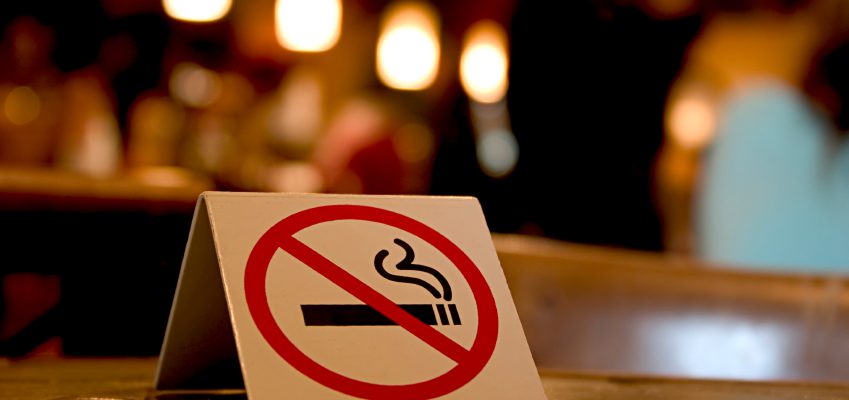Background
In 2011, the Wyoming Survey & Analysis Center (WYSAC) at the University of Wyoming, under contract to the Wyoming TPCP in the Wyoming Department of Health, conducted a survey of businesses across Wyoming to learn about their smoke-free policies. In 2016, the Wyoming TPCP worked with WYSAC to follow up on that survey, but narrowed the focus to hospitality businesses: restaurants, bars, and lodging establishments (including businesses that fit in more than one of those categories). The 2016 survey also expanded the scope of the survey to include policies about vaping (the use of electronic nicotine delivery systems [ENDS], also known as e-cigarettes). This report details the results of the 2016 study and provides conclusions and recommendations based on the data collected.
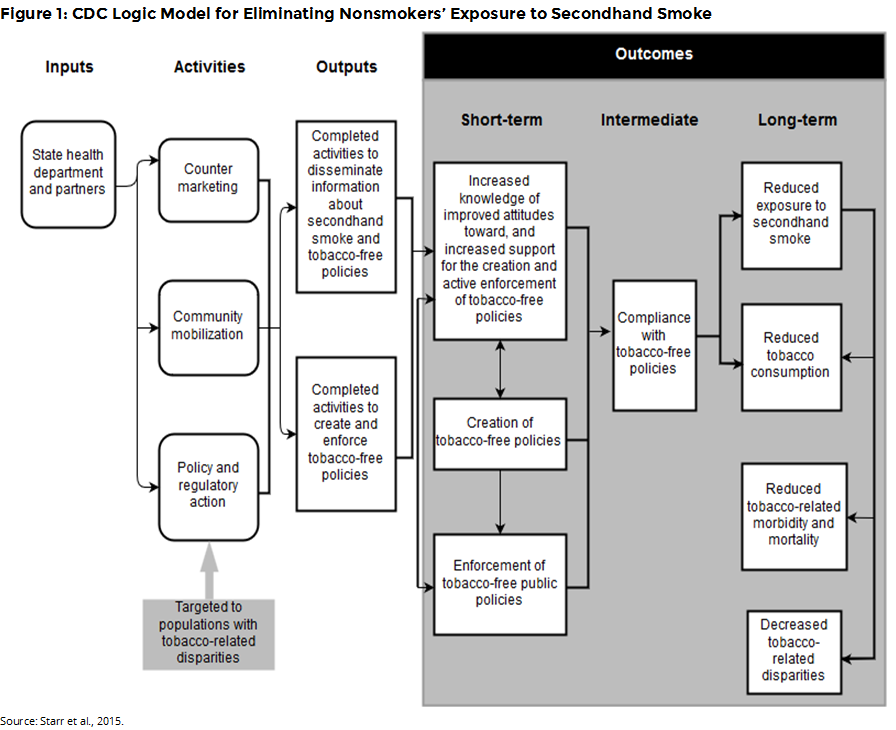
The Wyoming TPCP shares a goal with the federal tobacco prevention and control program: decrease exposure to secondhand smoke (Starr, et al., 2005). According to the Surgeon General (U.S. Department of Health and Human Services [USDHHS], 2014) and the Centers for Disease Control and Prevention (CDC, 2014) smoke-free air policies improve public health by reducing exposure to secondhand smoke. The preponderance (97%) of Wyoming adults agree with the statement, “Secondhand smoke is harmful to one’s health.” In 2012, 78% of Wyoming adults said the indoor areas of restaurants should be smoke-free, but only 47% said that indoor areas of bars, casinos, or clubs should be smoke-free (Wyoming Survey & Analysis Center [WYSAC], 2014). By increasing the number of smoke-free policies and laws in Wyoming, more residents will live, dine, and work in smoke-free environments. In time, the associated decrease in their exposure to carcinogens and other toxins should lead to a decrease in tobacco-attributable mortality and morbidity (Figure 1; Starr, et al., 2005). Smoke-free indoor air laws also contribute to social norms against smoking and reduce cigarette consumption and related health problems (CDC, 2014; USDHHS, 2014).
Wyoming has several local smoke-free laws of varying strengths, the first of which went into effect in 2005. Yet, 64% of Wyoming residents depend on voluntary business policies because they are not covered by any smoke-free indoor air law. An additional 8% of Wyomingites are not protected by a smoke-free indoor air law that includes bars. In places without comprehensive smoke-free indoor air laws, voluntary policies implemented by businesses can provide some protection to their employees and customers. Voluntary policies may also go beyond the scope of community laws by specifically incorporating ENDS, smokeless tobacco, or other tobacco products.
The Community Preventive Services Task Force regularly reviews the scientific literature to identify effective interventions for communities and businesses to implement to improve public health. They collect their findings in the online Guide to Community Preventive Services (The Community Guide). In 2012, they concluded that smoke-free indoor air laws are effective in reducing exposure to secondhand smoke as indicated by self-report surveys, analysis of biological tests for chemicals that indicate exposure to secondhand smoke, and readings of air quality in covered businesses. They also found connections between smoke-free indoor air policies and reduced prevalence and consumption of cigarettes by adults, increased cessation activity, reduced cardiovascular events and mortality, and reduced asthma-related hospital admissions linked to exposure to secondhand smoke. Although the task force did not specifically review voluntary business policies, it is logical to conclude they could contribute to similar effects, though not necessarily at a population level.
Some hospitality businesses (restaurants, bars, and lodging) offer smoking and non-smoking areas. In 2006, the Surgeon General concluded that such separation policies are not effective means to reduce exposure to secondhand smoke, even when adding ventilation to try to clear the smoke from the nonsmoking areas. Rather, ventilation may have the undesired effect of spreading smoke to nonsmoking areas (USDHHS, 2006). The National Institute for Occupational Safety and Health (NIOSH, 2015) recommends that all employers establish written policies that prohibit smoking and vaping in all indoor areas of their businesses to protect the health of their employees.
In the most recent Surgeon General’s report (USDHHS, 2016), there is evidence that people exposed to secondhand ENDS aerosol later test positive for nicotine. Though the degree of nicotine appears to be lower than for secondhand smoke, it is still enough to warrant caution, especially for populations vulnerable to the negative effects of nicotine, such as pregnant women. As is often the case when researching the health effects of ENDS, the heterogeneity of the devices and their aerosols has hampered research into the effects of secondhand ENDS aerosol. Additionally, the difference between measuring airborne secondhand smoke and secondhand ENDS aerosol may require different tools or interpretations of measurements.
Methods
Survey Administration
WYSAC and the Wyoming TPCP collaborated to develop two surveys of hospitality businesses: the Dining Survey (which included bars) and the Lodging Survey. The surveys were both developed to assess three types of business healthier air policies regarding smoke-free and vape-free indoor and outdoor air. WYSAC classified policies that provide smoke-free and vape-free air as clean air policies. Prior to distributing the surveys, WYSAC sent each business a letter from the TPCP asking for their participation. Both surveys were distributed between February 16, 2016, and May 4, 2016. Further details about the survey methods are reported in Appendix C.
Dining Survey
WYSAC invited 1,182 dining businesses across the state to complete the survey online or via mail. WYSAC invited a broad base of dining establishments to participate in the survey, including (but not limited to) bars, night clubs, cafes, full service restaurants, and fast food restaurants. A total of 277 businesses returned the survey, but some of these responses lacked sufficient data for analysis or indicated that the business was closed or ineligible. WYSAC used data from 264 dining businesses (22% of those invited to participate) to generate the findings discussed in this report.
Lodging Survey
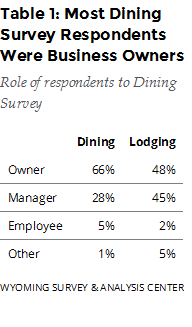 As with the Dining Survey, WYSAC invited a broad base of lodging businesses to participate in the lodging survey including (but not limited to) hotels, motels, ski lodges, campgrounds, bed-and-breakfasts, and recreational vehicle (RV) parks. Short term rentals, such as those offered through Airbnb, were not invited to participate. WYSAC invited 684 lodging businesses from across the state to participate in the survey online or by mailing a hard copy to WYSAC; 179 businesses responded to the survey. As with the Dining Survey, some of these responses did not provide sufficient data for analysis or were from closed or ineligible businesses. WYSAC used data from 166 returned surveys (24% of those invited to participate) to generate the findings for this report.
As with the Dining Survey, WYSAC invited a broad base of lodging businesses to participate in the lodging survey including (but not limited to) hotels, motels, ski lodges, campgrounds, bed-and-breakfasts, and recreational vehicle (RV) parks. Short term rentals, such as those offered through Airbnb, were not invited to participate. WYSAC invited 684 lodging businesses from across the state to participate in the survey online or by mailing a hard copy to WYSAC; 179 businesses responded to the survey. As with the Dining Survey, some of these responses did not provide sufficient data for analysis or were from closed or ineligible businesses. WYSAC used data from 166 returned surveys (24% of those invited to participate) to generate the findings for this report.
Participating Businesses
Most people who completed and returned the Dining and Lodging Surveys identified their roles as owner or manager, including any combination of those roles with other options listed on the survey (Table 1). Therefore, they should be well-informed about the policies they described in their responses.
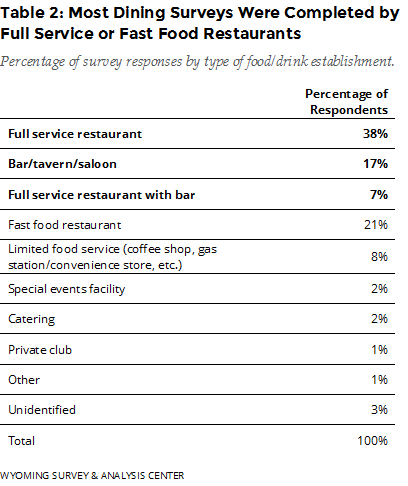 Standard Industrial Classification (SIC) codes are numeric codes that identify a type of business. WYSAC compared the primary SIC codes of the population invited to complete the surveys to the codes for the businesses that returned the survey. Some uncommon business types are not represented in the survey data. However, the percentages of business types represented in the sample are all similar to (less than a five-point difference) those calculated for the population. For example, 15% of the completed Dining Surveys came from businesses with the SIC code for “eating places;” 12% of the businesses invited to complete the survey had the same SIC code. Therefore, WYSAC treats the completed surveys as representative for each business type. Most respondents to the Dining Survey were completed by a combination of full service restaurants, fast food restaurants, and bars (Table 2).
Standard Industrial Classification (SIC) codes are numeric codes that identify a type of business. WYSAC compared the primary SIC codes of the population invited to complete the surveys to the codes for the businesses that returned the survey. Some uncommon business types are not represented in the survey data. However, the percentages of business types represented in the sample are all similar to (less than a five-point difference) those calculated for the population. For example, 15% of the completed Dining Surveys came from businesses with the SIC code for “eating places;” 12% of the businesses invited to complete the survey had the same SIC code. Therefore, WYSAC treats the completed surveys as representative for each business type. Most respondents to the Dining Survey were completed by a combination of full service restaurants, fast food restaurants, and bars (Table 2).
Most of the responding businesses for the Lodging Survey were motels or hotels. (Motels generally allow guest access directly from outside; hotels are generally defined as establishments with internal corridors that lead to guest rooms.) Several sites were multipurpose (e.g. a business that is both a motel and campground; Table 3).
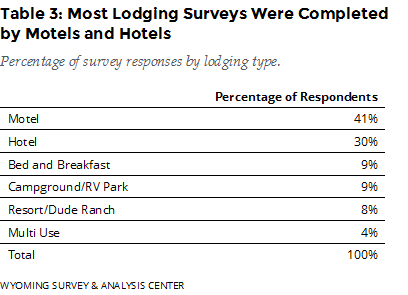 WYSAC compared the town addresses of the completed surveys to the town addresses of the businesses invited to participate in the survey. Some small towns were not represented in the completed survey data. However, the percentages of Wyoming’s dining and lodging businesses in each town in the sample were all similar (less than a five-point difference) to those calculated for the population. For example, 2% of the completed Lodging Surveys were from businesses in Laramie; 3% of lodging businesses invited to complete the survey had Laramie addresses. Therefore, WYSAC treats the completed surveys as geographically representative.
WYSAC compared the town addresses of the completed surveys to the town addresses of the businesses invited to participate in the survey. Some small towns were not represented in the completed survey data. However, the percentages of Wyoming’s dining and lodging businesses in each town in the sample were all similar (less than a five-point difference) to those calculated for the population. For example, 2% of the completed Lodging Surveys were from businesses in Laramie; 3% of lodging businesses invited to complete the survey had Laramie addresses. Therefore, WYSAC treats the completed surveys as geographically representative.
Analysis
WYSAC analyzed the survey with SPSS version 23 by running frequencies and percentages for each survey question (see Appendix A) and cross-tabulations on core questions with variables of interest. Because the data come from an attempted census of all Wyoming dining and lodging establishments, there was no statistical sampling bias. Thus, statistical tests that use sample statistics to make inferences about a population are not appropriate.
For the primary analysis, WYSAC identified a business as smoke-free indoors if (a) the business reported a written policy about smoking and (b) that policy prohibits smoking in all indoor areas of the business. WYSAC used equivalent standards to identify businesses as vape-free indoors. Businesses with written policies that prohibit smoking and vaping indoors qualified as having a clean air policy.
Because some businesses were uncommon among the respondents (and the population), WYSAC provides the number of respondents by business type in many of the tables below. WYSAC interprets results by business type with caution by excluding small groups when discussing the relative prevalence of different policies.
